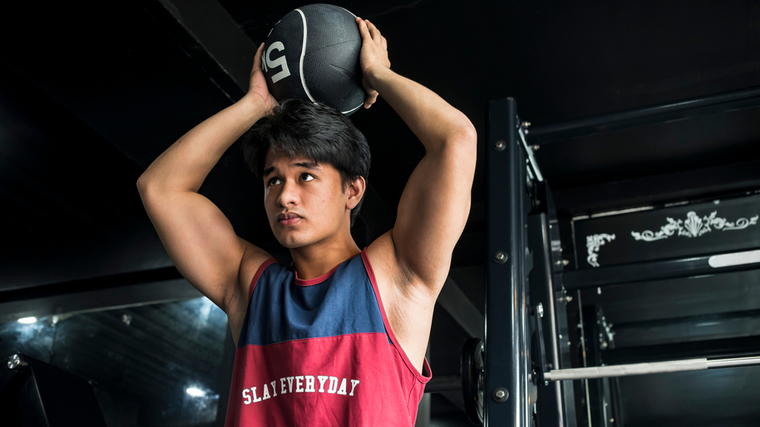Progress in the gym is much like the rest of life. It’s never in a straight line. There are times when you’re adding weight, adding reps, and making rapid gains. Then, the time comes when you and the barbell butt heads. No matter what you do or try, your progress comes to a halt. Then you have to figure out how to break through your strength training plateau.
Because when you’ve been lifting for a while, the dreaded plateau is sure to find you. A plateau can mean slightly different things for everyone. The most basic definition is that you’ve stopped being able to add weight to your lifts. You might also be having trouble adding more reps to your set. Or, you thought you’d be less out of breath after working for weeks with sets of five squats, but they still take the ever-loving wind out of you.

If you’ve been training hard in the gym, plateaus can sneak up on you and demoralize even the most mentally disciplined lifters. This article will take you through eight strategies to break through a strength training plateau. It’ll also discuss what a plateau is, why they happen, and how to choose which plateau-busting method is right for you.
How to Break Through a Strength Training Plateau
- Stick with Your Current Plan
- Target Your Weaknesses
- Move in All Planes of Motion
- Incorporate Time Under Tension
- Plan a Deload Week
- Sleep More
- Do More Mobility Work
- Take Time Off
Stick with Your Current Plan
A lot of people run into strength plateaus because they don’t stick with one training strategy long enough to see it work. It’s understandable — an eight-week cycle can feel very long. If after the third or fourth week, you’re not feeling stronger or more muscular, you might prematurely decide the program isn’t working.
While changing up your training strategy can be beneficial, make sure you’ve truly plateaued before switching it up. Ask yourself whether you’re frustrated because progress feels slow or if your numbers have started stalling. If you can hit the prescribed weights, reps, and sets each week of your program, you’re probably experiencing frustration rather than a temporary strength peak. Incorporating mindfulness strategies into your program can help you stick with it long enough to give it time to pay off.
Target Your Weaknesses
Are you stronger with your right arm than your left? Try unilateral training to even out those imbalances for re-starting your progress. Or maybe your hips or ankles might not be mobile enough to support that truly heavy squat you’ve been aiming for. Mobility training is sure to help you there. If you’re having trouble coming out of the hole in your squat, pause squats can come to the rescue. Whatever your situation, identifying and then targeting your individual weaknesses can help you break through any plateau.
Move in All Planes of Motion
Especially if you’re a powerlifter, you probably spend most of your time moving in the sagittal plane — that’s up and down movement. But moving in the frontal and transverse planes are also hugely important for your strength goals.

Frontal plane movements happen from side-to-side. An example of this is lateral lunges. Transverse plane movements often involve rotation, like rotational medicine ball throws. Moving through all the fundamental movement patterns can balance your program and help you move better overall. And the better you move, the better you can lift.
Try adding different kinds of movement to your warm-ups, cool-downs, and some light strength training. This will help you amp up your training without adding a recovery burden.
Incorporate Time Under Tension
The three main triggers for muscle hypertrophy are mechanical tension, metabolic stress, and muscle damage. Adding a pause into your big lifts covers all three bases, if somewhat brutally.
Pauses work best with compound lifts like deadlifts, squats, presses, rows, and isolation exercises to bring up a lagging muscle group.
You can also try upping the intensity and increasing time under tension by performing a rep and a half. You take an exercise and extend the set by inserting a half rep after a full range of motion rep. Adding a partial rep during most strength training exercises will increase your muscles’ time under tension, helping you feel the exercise more and address any technique flaws. This works with accessory work such as single-leg exercises, rows, and pressing variations. It’ll help you build up strength and muscle in a particular body part.
Tempo training is another way to increase time under tension and help you when your lifts stall.
Manipulating your lifting tempo forces you to slow things down and focus on your form. Any hitches in the lift will be easier to spot if you’re going slowly. Furthermore, you’ll accumulate more time under tension, which is a key component in building strength and muscle. For compound movements, using 70 to 80 percent of your one-rep max for six to 12 reps is a good starting point.
Plan a Deload Week
If your lifting progress has stalled, instead of going harder, consider going lighter. Program a deload week where you lift much lighter for more reps and increase your focus on mobility. Taking a deload week can help reset your body, shaking off any mental and physical fatigue that may have built up and interrupted your progress.
Deload weeks don’t only have to mean lifting less weight. It can also mean lifting different kinds of weight. For example, kettlebells can help bust plateaus. Perhaps you’ll incorporate resistance band work into your deload training to help refine your technique. However you program your deload week, make sure you’re treating each movement with respect and moving with integrity.
Sleep More
You can be working the world’s best training program and crushing it in the gym — and still make little or no progress. If you can’t find any in-the-gym explanation for your plateaus, it might be time to take a look at your sleep schedule.
Athletes need to sleep to recover from the incredible amount of strain they put their bodies (and minds) under during training. Seven hours of sleep may work for some adults, but it just might not cut it if you’re training intensely. If you’ve never made sure to get more sleep when you’ve ramped up your training, consider making sleep just as big a focus as your barbell time. Not sleeping enough can leave some serious strength gains on the table.
Do More Mobility Work
You don’t need to only perform long mobility sessions to improve your joint health and strength at your end ranges of motion. But if your lifting progress has stalled because your mechanics break down when the weights get heavy, consider more mobility work. You can pepper your days with five-minute mobility sessions or integrate this kind of training into your warm-ups, cool-downs, and between-set movements.
Mobility training can improve your lifts by ironing out any mechanical weaknesses in your movement patterns. Emphasizing mobility will also add quality movement to your program without adding to your recovery needs — in fact, it’ll help with recovery. And the more refined your recovery program is, the more likely your in-gym training will start to progress again.
Take Time Off
Taking time off from the gym is a different beast than taking a deload week. With a deload week, you’re still working a program and performing lifts, but with less weight and reduced volume. Time off from training is different. Maybe you’ll go on some light jogs, long walks, and move through yoga flows — but you won’t be strength training.
Even though it might seem counterintuitive, taking time away from your box or home gym can recharge your body and mind. This is an especially good strategy if your plateau has come from overreaching too much or if your motivation is waning. Spending some time away from your dumbbells can make you that much more excited to come back refreshed and ready to lift heavier.
What is a Strength Training Plateau?
Strength training plateaus are when your progress in the gym has stalled. That might mean that no matter how hard you try, you can’t seem to lift more than 135 pounds for your bench press max. Your plateau might also look like being absolutely unable to catch your breath after that set of five reps you’ve been working on for a long time now.
[Read More: Powerbuilding Workout Routine, With Tips from a CPT]
Whatever a plateau looks like for you, the short story is that your progress toward your gym goals has stalled. You might hit a plateau for only one of your lifts — your bench press is improving well, but your overhead press isn’t going anywhere. Or your progress might have ground to a halt all across the board — none of your lifts are getting better.
Plateaus can happen for any number of reasons. You might not be training a particular lift hard enough or often enough. Or, you may just not be sleeping enough. If there’s a specific part of one or two lifts that keeps stalling out, your plateau might be more mechanical in nature. Focused mobility training can come to your rescue when your heavy squats keep grinding to a halt when your hips and knees just won’t break properly.
How to Choose a Plateau-Busting Method
To address halted progress in the gym, you’ll need to figure out why it’s happening first.
The reason for your plateau will generally dictate the solution. For example, if all your mechanics are good but your lifts have stalled across the board, you might be looking at an outside-the-gym issue. Perhaps you’re not sleeping enough for how intensely you’re training, which can eat away at muscle and strength gains. If you’re feeling overwhelmed and burnt out, you may need a deload week or even a complete break from training.
View this post on Instagram
On the other hand, your plateau might be more specific to one or two lifts. In this instance, identify which lifts you’re stalling in. Consider filming yourself performing them so you can see when during exercises you being to fail. Does your bench press stall before lockout or when you’re coming off of your chest? Consider various forms of tempo training to address the issue. Maybe your overhead press is unstable at the top. Address your weaknesses with some unilateral training and overhead stability work. The more specific you get with your strategies, the better.
Slow Down to Speed Up
The key to breaking through strength training plateaus doesn’t lie in tossing more plates onto the bar and hoping for the best. Instead, identify the weaknesses that might be causing the plateau and proceed from there. More often than not, plateau-busting may involve slowing down rather than speeding up your training. Taking it easier in and out of the gym can work wonders for helping you come back that much stronger.
Featured Image: Dragon Images / Shutterstock